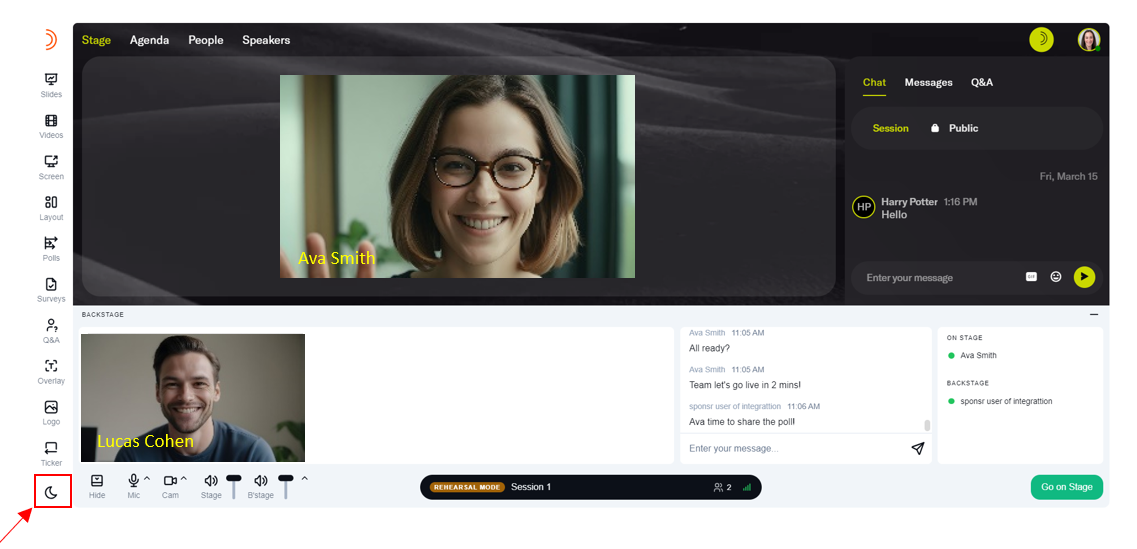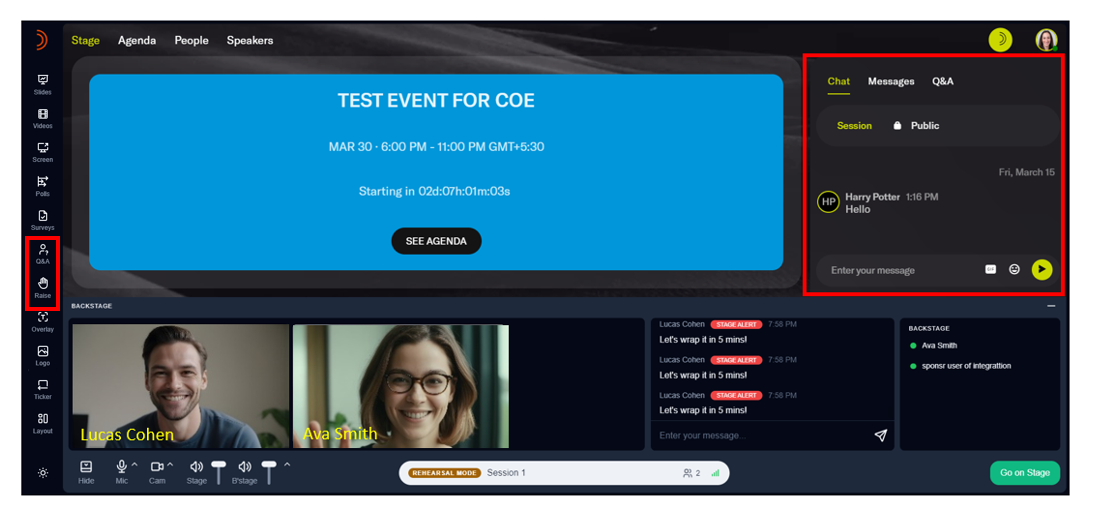Is this your first time as a Goldcast event producer?
Hosting a Goldcast event is intuitive and easy, thanks to our enhanced stage controls. We’ve put together this handy step-by-step guide to help you seamlessly run your Goldcast event.
Step 1: Enter backstage
Click on your unique magic link to the event. This will take you to the event landing page. Click Enter Backstage next to the session you're hosting.

If you have access to Goldcast Studio, open your event and navigate to Program → Staff using the left sidebar. Click on the URL next to your name to copy your magic link, and open this link in your browser to enter the event's backstage.

Do not share this link with anyone - this is your unique personal event access link.
Step 2: Complete the tech check
Goldcast performs a quick tech check to ensure your microphone, camera, and speaker are connected and working as required.
Optional: You can select a virtual background and test the screen share feature during the tech check.
Once everything is checked, click Enter Event to proceed to the next screen.
Step 3: Get ready backstage

This takes you backstage, a private space for speakers and event staff. This area is accessible only to speakers, producers, and coordinators; attendees cannot see what’s happening backstage.
The backstage area has several tools and features to help you host and run the event. Here’s a quick run-through of the different components:
Event status
A status bar at the bottom of the screen indicates the current event status.
- When you enter the event before it goes live, the status displays as Rehearsal Mode. We recommend joining the event before the scheduled time to familiarize yourself with the various controls.

- The status changes to Live when the event goes live.
Heads up! In automatic redirection, the LIVE tag will stay visible for 30 minutes after the last/single session ends. This indicates that speakers or any content shared on stage after the session's end time will be visible to the audience and will be captured in the recording. So, make sure to instruct speakers to Leave Stage and remove any content shared onstage to avoid capturing any unintended content.
Audio and video controls
The audio and video controls are at the bottom left of the screen.
- Hide - Hide and show the backstage area.
-
Mic - Mute/unmute yourself. Click the Chevron icon
 next to it to change your preferred microphone device.
next to it to change your preferred microphone device. -
Cam - Hide/show your camera feed. Click the Chevron icon
 next to it to change your camera device.
next to it to change your camera device. - Stage volume - Increase, decrease, or mute the stage volume
-
B’stage (Backstage) volume - Increase, decrease, or mute the backstage volume. Click the Chevron icon
 to open speaker settings and change your virtual background or connected audio and video devices.
to open speaker settings and change your virtual background or connected audio and video devices.
Note: Attendees never hear the backstage feed.
Backstage video

The left panel shows the video feeds of all speakers and event staff currently backstage.
Heads Up: This video feed is only for backstage members; the audience cannot view it. The audience can only see and hear speakers/producers when they Go on Stage and the session is live.
Backstage chat

The backstage chat is a private channel just for speakers and event staff. Attendees cannot view it. So, feel free to use this chat to give instructions to speakers during the event and partake in real-time conversations with the rest of the event team.
Dark and light mode
 |
 |
| Dark mode | Light mode |
Click the sun/moon icon at the bottom left of the backstage to toggle between dark and light modes.
Step 4: Begin the session
If your session is in manual redirection mode, click the Start Session button to begin it.
Heads up! The Start Session button will be visible only after the Event Start Time has passed.

However, if your session is in automatic redirection mode, it’ll begin automatically at the scheduled time. You’ll see an on-screen countdown timer before the session goes live.

Note: Even when the session is live, attendees will not be able to see you until you proactively join the stage by clicking the Go on Stage button.
Step 5: Go on stage
Depending on your event format, you might want to go on stage to welcome the audience and introduce the speaker(s). When you’re ready, click the Go On Stage button.

This takes you to the stage, and the audience can see and hear you. Use the camera and microphone icons at the bottom of the screen to mute or hide your video, as required.
- By default, Goldcast mutes the Backstage (B’stage) volume when you join the stage. This is handy, as it helps you focus on your presentation without being distracted by backstage conversations.
- Use the volume buttons to increase/decrease the stage and backstage volumes according to your comfort level.
- While on stage, you can still converse with the speaker(s) and other organizers backstage by using the backstage chat. The backstage chat feed is never visible to the audience.
Step 6: Manage speaker actions

The rightmost backstage panel indicates speakers and organizers' current status and location. A green dot is displayed next to speakers and organizers currently online. This panel also shows whether a particular speaker or organizer is on stage or backstage at any moment.
To move a speaker to the stage, click the speaker’s name on the status panel and select Move on Stage.

Once the speaker accepts the invitation, Goldcast moves them to the stage. While the speaker is on stage, you can click the speaker’s name to mute or move them off stage.

You can also send on-stage messages to speakers to grab their attention or share real-time instructions. These alerts are only displayed to the speaker, and the audience cannot see them.
Step 7: Use video production tools
Goldcast offers a variety of video production tools to make your sessions engaging and interactive. You can find these tools in the left panel of your screen.

Use the presentation and video production tools to the left of the stage to:
- Share preloaded slides, videos or your screen with the audience.
- Open and launch polls, surveys
- Respond to audience Q&A and accept video Q&A requests
- Share a message that takes over the full stage or publish a scrolling ticker
- Share a logo/image to the stage
- Change the stage layout
 Note: Depending on the asset you share, you might not be able to share other assets simultaneously on stage. For example, if you’re presenting a slide deck, you’ll need to stop sharing it before you can share your screen. However, other assets like the ticker and logo can be shared simultaneously with other content on stage.
Note: Depending on the asset you share, you might not be able to share other assets simultaneously on stage. For example, if you’re presenting a slide deck, you’ll need to stop sharing it before you can share your screen. However, other assets like the ticker and logo can be shared simultaneously with other content on stage.
Interacting with the audience

The attendee engagement panel on the right lets you view and participate in audience chat. Click the Q&A icon on the left panel to respond to audience queries. Click the Raise icon to accept or dismiss video Q&A requests. If accepted, the attendee shares the stage with the speaker(s).
Step 8: Leave the stage
Once done, click Leave Stage to move off the stage and go backstage. Remove all shared media and move speakers off stage to stop the session recording.
If your event is in manual redirection, click the End Session button to stop the session.

Click End Session in manual redirection
In automatic mode, as the session reaches its scheduled end time, you’ll see a countdown timer across the top of the stage, and the session automatically ends at the scheduled time.

To navigate to another session in the event, click Agenda in the top navigation bar, click Enter Backstage and repeat the steps above.

Quick Tips
- Do a practice run while your session is in rehearsal mode to get comfortable with stage controls. Practice starting and stopping your video, muting and unmuting your microphone, going on and off stage, sharing your screen, videos, slides, messages, tickers, and images, changing the stage layout, and starting and ending sessions.
- Make sure you join from a noise-free environment. A good headset with a microphone is recommended for audio clarity, though it’s not mandatory.
- For the best audio and video results, ensure that your internet connection is stable and fast. If your device is connected to Wi-Fi, moving closer to the router can improve internet speed and stability. Connecting your device to the router directly via an Ethernet cable can help with connectivity issues.
- Join from your laptop/desktop via the Chrome browser.
- Sometimes, ad-blockers and anti-virus browser extensions can interfere with your Goldcast sessions. Disabling these extensions temporarily can help.
- Close all other apps and browser tabs on your computer, and turn off all notifications that might interrupt your presentation.
Voila! You’re now ready to host and organize a great event!
Pro Tip: Review our pre-event checklist to ensure everything is set for your big day.
Need more help? Contact support@goldcast.io or connect with your CSM.


